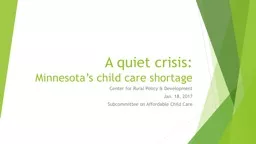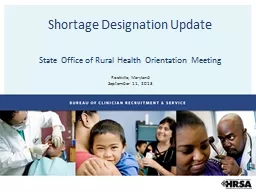PPT-A quiet crisis: Minnesota’s child care shortage
Author : mitsue-stanley | Published Date : 2018-02-25
Center for Rural Policy amp Development Jan 18 2017 Subcommittee on Affordable Child Care Child care A statewide issue Center for Rural Policy amp Development As
Presentation Embed Code
Download Presentation
Download Presentation The PPT/PDF document "A quiet crisis: Minnesota’s child care..." is the property of its rightful owner. Permission is granted to download and print the materials on this website for personal, non-commercial use only, and to display it on your personal computer provided you do not modify the materials and that you retain all copyright notices contained in the materials. By downloading content from our website, you accept the terms of this agreement.
A quiet crisis: Minnesota’s child care shortage: Transcript
Center for Rural Policy amp Development Jan 18 2017 Subcommittee on Affordable Child Care Child care A statewide issue Center for Rural Policy amp Development As of April 2016 These numbers are always changing MN DHS updates them monthly. Osamu Tajima (KEK). The QUIET Collaboration. 1. B-modes have . NOT. been observed . yet. ! . Direct limits : . r. < 0.7. (ground experiment). Indirect limits: . r. < . 0.2. Contribution from. Q/U Imaging . ExperimenT. . Osamu Tajima (KEK). QUIET collaboration. 1. Age . . 10. -. 36. . sec. . 380 . Kyr. . 1 . Myr. . . Mental Health Professional Shortage Areas (MHPSA):. MHPSAs are communities within a State that are federally recognized as having a shortage of mental health providers (i.e. . Psychiatrists. , Core Mental Health Providers) to treat the population of that area. 1. Coal Shortage in India-. Way Forward. . U Kumar. Advisor (Coal. Essel Mining & Industries Ltd . Aditya Birla Group. . Coal Shortage in India-Way Forward (14.8.14). Ece Akca. Ege University. Heidi A. Wayment & Meliksah Demir. Northern Arizona University. Nebi Sumer. Middle East Technical University. Outline. Introduction. The Quiet Ego. Personality Characteristics. and Still. Geraldine . Doggett. I . stretch my hands above my head,. I shake them all around. . I let them fall don’t slowly, . they won’t make a sound.. I . rest them on my knees, . I keep my body steady.. California. Health Professional Shortage Area. Medically Underserved Population. Medically Underserved Area. Brenda . Pérez. UP 206A. Winter . 2011. Shortage Designation Program. Federal program under the Health . Quiet Revolution. The Quiet Revolution, also known as . La Revolution . Tranquille. , . began in Quebec in 1960 with the electoral defeat of the Union . Nationale. by Jean Lesage and his Liberal . Party. Arkansas Department of Education. Each year the . US Dept. of Education (USDOE) asks . states to identify teacher . Academic . Shortage . Areas. . . These Shortage . Areas are . considered to be . areas of need in . Status Update. WACTE Meeting: April 26, 2017. J. . Lee . Schultz. Assistant . Director for Teacher . Shortage. Status update. Student Teaching Grant application cycle results. Upcoming launch of Teacher Shortage Conditional Grant. State Office of Rural Health Orientation Meeting . Rockville, Maryland . September 11, 2013. Become familiar Shortage Designation . Branch. Gain . an understanding of . Shortage Designation Types. Gain an understanding of . Story adapted by: . Adrienne Flick. Caitlin . Gilmartin. And The . MEC Professionals . of 2/15/2015 . From: . Teachtown. Social Skills. The students are working in the classroom. . Mochi. is counting his cards quietly. . Ann McCully, Executive Director. Our Mission. We are a statewide early childhood leader driving change through partnerships to build an equitable, high-quality early care and education system that . meets the needs of Minnesota’s families and... Experience the best eye care center in Pune. The best clinics for your eye health, include the prestigious Dr. Sonalika Eye Clinic. At Hadapsar, Amanora, Magarpatta, Mundhwa, Kharadi Rd, Viman Nagar, Wagholi, and Wadgaon Sheri
Download Rules Of Document
"A quiet crisis: Minnesota’s child care shortage"The content belongs to its owner. You may download and print it for personal use, without modification, and keep all copyright notices. By downloading, you agree to these terms.
Related Documents














